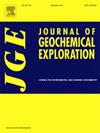赞比亚铜带植物地球化学勘探的原生植物物种筛选
IF 3.3
2区 地球科学
Q1 GEOCHEMISTRY & GEOPHYSICS
引用次数: 0
摘要
植物组织微量元素分析有助于赞比亚铜带(ZCB)沉积物中铜钴矿床的找矿。这项研究是在Mitumba勘探区进行的,该地区已知有铜矿,但历史上没有采矿活动,以确定最能指示矿化带的本地植物物种及其组织。野外调查和生态分析共鉴定出12科22种本地植物,以豆科植物(36.4%)为主。在种水平上,根据包衣指数鉴定出优势种,其中有人科(Lamiaceae)的humanastrum katangense、姜科(gingiberaceae)的Aframomum angustifolium、豆科(Fabaceae)的Brachystegia boehmii和夹竹桃科(Apocynaceae)的Diplorynchus condilocarpon。在已知矿化带上方和矿化区外的控制点对土壤和植物器官进行了采样。根据转运因子(translocation factors, TF) > 1,大多数物种将Cu从根转移到地上生物量,但只有humanastrum katangense、Aframomum angustifolium和Diplorynchus condilocarpon这3种物种既能从根际转移又能生物浓缩(BCF > 1)生物可利用的Cu,这使它们成为植物地球化学探索的理想候选国。只有人猿(humanmaniastrum katangense)和阿夫拉蒙(Aframomum angustifolium)积累了Co。植物根系和叶片显示出显著的Cu异常,并且与土壤相比显示出更大的异常值种群。统计和机器学习技术都表明,土壤Cu浓度与植物根和叶片中Cu含量之间存在显著关系,突出表明土壤pH、有机质和粘土含量是影响土壤-植物系统中金属生物有效性的主要理化变量。本文章由计算机程序翻译,如有差异,请以英文原文为准。
Native plant species screening for phytogeochemical exploration in the Zambian Copperbelt
Trace element analysis of plant tissues can aid mineral exploration for sediment hosted Cu-Co deposits in the Zambian Copperbelt (ZCB). This study was conducted at the Mitumba prospect, an area in the ZCB known to have copper minerals but no historical mining activities, to identify native plant species and their tissues that are most indicative of mineralized zones. Field inventory and ecological analysis identified 22 native plant species from 12 different families, of which Fabaceae (36.4%) was dominant. At species level and based on the coating index, we identified several predominant species, among them, Haumaniastrum katangense (Lamiaceae), Aframomum angustifolium (Zingiberaceae), Brachystegia boehmii (Fabaceae), and Diplorynchus condilocarpon (Apocynaceae). Sampling was undertaken of soils and plant organs above the known mineralized zone and at control points outside of the mineralized area. Most species translocated Cu from the roots to the aboveground biomass as indicated by translocation factors (TF) 1 but only three species, namely, Haumaniastrum katangense, Aframomum angustifolium and Diplorynchus condilocarpon can both translocate and bioconcentrate (BCF 1) bioavailable Cu from the rhizosphere, making them ideal candidates for phytogeochemical exploration. Only Haumaniastrum katangense and Aframomum angustifolium accumulated Co. Plant roots and leaves demonstrate significant Cu anomalism and show a wider population of anomalous values compared to the soils. Statistical and machine learning techniques both indicate significant relationships between soil Cu concentration and the content of Cu in plant roots and leaves highlighting soil pH, organic matter and clay content as the major physicochemical variables influencing metal bioavailability in soil-plant systems.
求助全文
通过发布文献求助,成功后即可免费获取论文全文。
去求助
来源期刊

Journal of Geochemical Exploration
地学-地球化学与地球物理
CiteScore
7.40
自引率
7.70%
发文量
148
审稿时长
8.1 months
期刊介绍:
Journal of Geochemical Exploration is mostly dedicated to publication of original studies in exploration and environmental geochemistry and related topics.
Contributions considered of prevalent interest for the journal include researches based on the application of innovative methods to:
define the genesis and the evolution of mineral deposits including transfer of elements in large-scale mineralized areas.
analyze complex systems at the boundaries between bio-geochemistry, metal transport and mineral accumulation.
evaluate effects of historical mining activities on the surface environment.
trace pollutant sources and define their fate and transport models in the near-surface and surface environments involving solid, fluid and aerial matrices.
assess and quantify natural and technogenic radioactivity in the environment.
determine geochemical anomalies and set baseline reference values using compositional data analysis, multivariate statistics and geo-spatial analysis.
assess the impacts of anthropogenic contamination on ecosystems and human health at local and regional scale to prioritize and classify risks through deterministic and stochastic approaches.
Papers dedicated to the presentation of newly developed methods in analytical geochemistry to be applied in the field or in laboratory are also within the topics of interest for the journal.
 求助内容:
求助内容: 应助结果提醒方式:
应助结果提醒方式:


